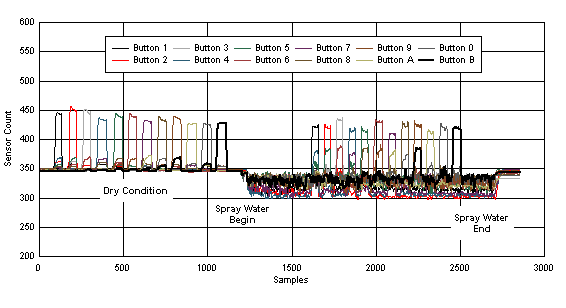TIDUE90 July 2018
- Description
- Resources
- Features
- Applications
- Design Images
- 1System Description
- 2System Overview
- 3Hardware, Software, Test Requirements, and Test Results
- 4Design Files
- 5Software Files
- 6Related Documentation
- 7About the Author
3.2.3.2 Continuous Water Spray Test
Figure 27 shows that the sensors are calibrated at a baseline count of 350, and a touch increases the count to approximately 450 in dry conditions. The increased delta is smaller compare than in the well grounded power supply scenario. When the spray water is applied on the touch sensor area, the data shows the "negative touch" behavior (see Section 2.2.3.2). The water spray causes the measurement result to go in the opposite direction of a touch event, so no false touch is detected. While the water is continuously spraying on the touch sensor area, each touch event still causes a count increase, and the touched button is still distinguishable. The sensitivity under the water spray condition is comparable with the sensitivity under the dry condition, which means that the touch threshold can be set to reliably work for both dry and spray water conditions.
 Figure 27. Sensor Count Result With Continuous Water Spray (Battery Power)
Figure 27. Sensor Count Result With Continuous Water Spray (Battery Power)